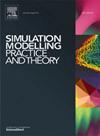The Bevel Local Slope Approach: A method for mesh stiffness estimation in spur, helical and spiral bevel gears
IF 3.5
2区 计算机科学
Q2 COMPUTER SCIENCE, INTERDISCIPLINARY APPLICATIONS
引用次数: 0
Abstract
The local slope approach proved to be very useful in recent studies as a method to generate the gear mesh stiffness of spur gears. This study seeks to adopt this approach and apply it to the analysis of the gear mesh stiffness of bevel gears. The objective therefore extends beyond the validation of results obtained with an updated version of the method named the bevel local slope approach. This approach is considered as a finite element method that is based on a first-order finite difference approximation using the non-linear force–deflection response of the gear pair. CADs are prepared and optimum FE meshing is generated to realize simulations for several increments dividing a single meshing period. The results obtained with this approach are compared to the analytical approach of Weber and Banascheck. The goal is to illuminate potential challenges associated with the aforementioned method. A key observation is the phenomena occurring in the body of the gear as a torsional deformation at a direction different to the direction of rotation. The method proved to be very useful not only for straight bevel gears, but also for helical and spiral shapes.
锥面局部斜率法:一种估算正齿轮、斜齿轮和螺旋锥齿轮啮合刚度的方法
局部斜率法作为一种计算直齿轮啮合刚度的方法在近年来的研究中得到了广泛的应用。本研究试图采用这种方法,并将其应用于分析锥齿轮的齿轮啮合刚度。因此,目标超出了用称为斜面局部斜率方法的更新版本获得的结果的验证。该方法被认为是一种基于一阶有限差分近似的有限元方法,该方法利用齿轮副的非线性力-挠度响应。编制cad并生成最优有限元网格,以实现划分单个网格周期的多个增量的仿真。用这种方法得到的结果与Weber和Banascheck的分析方法进行了比较。目的是阐明与上述方法相关的潜在挑战。一个关键的观察是现象发生在齿轮体作为扭转变形在不同的方向上的旋转方向。该方法不仅适用于直齿锥齿轮,而且适用于螺旋形和螺旋形锥齿轮。
本文章由计算机程序翻译,如有差异,请以英文原文为准。
求助全文
约1分钟内获得全文
求助全文
来源期刊

Simulation Modelling Practice and Theory
工程技术-计算机:跨学科应用
CiteScore
9.80
自引率
4.80%
发文量
142
审稿时长
21 days
期刊介绍:
The journal Simulation Modelling Practice and Theory provides a forum for original, high-quality papers dealing with any aspect of systems simulation and modelling.
The journal aims at being a reference and a powerful tool to all those professionally active and/or interested in the methods and applications of simulation. Submitted papers will be peer reviewed and must significantly contribute to modelling and simulation in general or use modelling and simulation in application areas.
Paper submission is solicited on:
• theoretical aspects of modelling and simulation including formal modelling, model-checking, random number generators, sensitivity analysis, variance reduction techniques, experimental design, meta-modelling, methods and algorithms for validation and verification, selection and comparison procedures etc.;
• methodology and application of modelling and simulation in any area, including computer systems, networks, real-time and embedded systems, mobile and intelligent agents, manufacturing and transportation systems, management, engineering, biomedical engineering, economics, ecology and environment, education, transaction handling, etc.;
• simulation languages and environments including those, specific to distributed computing, grid computing, high performance computers or computer networks, etc.;
• distributed and real-time simulation, simulation interoperability;
• tools for high performance computing simulation, including dedicated architectures and parallel computing.
 求助内容:
求助内容: 应助结果提醒方式:
应助结果提醒方式:


